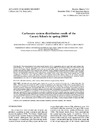Please use this identifier to cite or link to this item:
https://accedacris.ulpgc.es/jspui/handle/10553/49802
| Title: | Carbonate system distribution south of the canary islands in spring 2000 | Other Titles: | Distribución del sistema del carbonato al sur de las Islas Canarias en la primavera del año 2000 | Authors: | Ucha, Iván R. González-Dávila, Melchor Santana-Casiano, Magdalena Rueda, María José Llinás-González, Octavio |
UNESCO Clasification: | 251002 Oceanografía química | Keywords: | Carbonate chemistry Water masses Eddies Nutrients Oxygen, et al |
Issue Date: | 2010 | Publisher: | 0214-8358 | Project: | Marine Carbon Sources And Sinks Assessment (Carboocean) Modelo Físico-Químico Para la Región Macaronesica. Evaluación y Potencial Aplicación Aperacional |
Journal: | Scientia Marina | Conference: | 14th Iberian Seminar on Marine Chemistry | Abstract: | The measurement of the surface molar fraction of CO2 (atmosphere and sea water) and water column pHT, total alkalinity, AT, nutrients and oxygen were carried out in spring 2000 at the European Station for Time Series in the Ocean at the Canary Islands (ESTOC) and in the area located south of the Canary Islands. The significant eddy field strongly affecting the pattern of the chemical and carbonate system variables is presented and discussed. A mixing model based on the thermohaline properties of the water masses was established. The model explained over 97% of the variability found in the distribution of the chemical variables. Intermediate waters to the south of the Canary Islands show a high contribution of Antarctic waters with about 5% of pure Antarctic Intermediate Water. Moreover, the surface structure affected the atmosphere-ocean carbon dioxide exchange, making the area act as a CO2 sink taking up 9.1 mmol m-2 week-1, corresponding to 0.03 Mt of CO2 which were taken up by the area in a week at the end of March 2000. Durante la primavera del año 2000 se realizaron medidas en las aguas superficiales de la fracción molar de CO2 (atmósfera y océano) y en la columna de agua de pHT, alcalinidad total, AT, nutrientes y oxígeno, para la Estación Europea Oceánica de Series Temporales de Canarias (ESTOC) y al sur de las islas Canarias. En este trabajo se presenta y discute el efecto del importante campo de remolinos presente en el área sobre la distribución de las variables químicas y del sistema de carbonato. Se ha establecido un modelo de mezcla, basado en las propiedades termohalinas de las diferentes masas de agua, que explica el 97% de la variabilidad encontrada en la distribución de las variables químicas. Las aguas intermedias al sur de las islas Canarias están caracterizadas por la alta contribución del agua Antártica intermedia diluida, que corresponde con una contribución próxima al 5% de agua Antártica intermedia pura. Por otro lado, las estructuras superficiales afectan al intercambio de CO2 atmósfera-océano, actuando el área como un sumidero de dióxido de carbono incorporando 9.1 mmol m-2 semana-1, que se corresponde con 0.03 MTon de CO2 captadas por el área y en una semana a finales de marzo del 2000. |
URI: | https://accedacris.ulpgc.es/handle/10553/49802 | ISSN: | 0214-8358 | DOI: | 10.3989/scimar.2010.74s1033 | Source: | Scientia Marina [ISSN 0214-8358], v. 74, p. 33-46 |
| Appears in Collections: | Artículos |
SCOPUSTM
Citations
1
checked on Jun 8, 2025
WEB OF SCIENCETM
Citations
1
checked on Jun 8, 2025
Page view(s)
89
checked on May 23, 2024
Download(s)
92
checked on May 23, 2024
Google ScholarTM
Check
Altmetric
Share
Export metadata
Items in accedaCRIS are protected by copyright, with all rights reserved, unless otherwise indicated.
